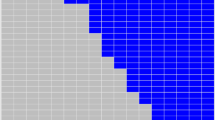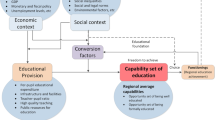Abstract
In 1999, the Utah State Legislature allowed charter schools to enter and be administered under the broad oversight of school districts. The structure of the Utah Charter School provides a natural experiment to study a unique way that traditional public schools compete against new charter schools. Using data from the 1992–2012 waves of the Common Core of Data, we estimated fixed effect models to measure the increase in capital expenditures by traditional public schools when faced with competition by new charter schools. We find that total capital outlay and spending on improving existing structures increases with charter competition, but new construction and instructional spending does not increase at a statistically significant level.


Similar content being viewed by others
Notes
Stoddard and Corcoran (2007) show that publicly funded charter schools are more likely to enter in places where income inequality is higher and school performance is poorer. In addition, research suggests that teachers’ unions are effective in slowing down or preventing policies that are helpful to charter schools.
Toward the end of the nineteenth century, similar references can be found to the imprudence reflected in the over-investment in bank buildings. Townsend (1881) shares the following insight, “Extravagant amounts spent for palatial buildings to be used simply for banking offices, or even if a part of the bank is rented, has an ill effect on its depositors and the community. It is not only unwise and unjust to expend deposits or surplus in this way, but the example taught is unqualifiedly bad. When depositors see the costly buildings, and on entering are startled at the sumptuous furnishings, one lesson of economy or thrift is taught them, even if the portrait of Franklin larger than life is posted in a conspicuous place, with the motto ‘Save your pennies.’ They learn rather that trustees who build such banking houses are not the proper custodians of their savings...”.
Gronberg et al. (2015) find that while school district consolidation can take advantage oft economies of scale, especially in student transportation, increased market concentration causes school districts to become more cost inefficient. Glomm et al. (2005) show that charter schools tend to enter districts with poorer preforming schools. However, whether those schools capture efficiency gains from increased competition is unclear since charters tend to enter markets where private schools already are operating. Couch et al. (1993) show that an increase in competition from private schools increases algebra test schools in public schools in North Carolina. Thus, increased competition for students can cause efficiency gains and better student outcomes in public schools.
Compare these findings to the literature showing a clear improvement in student outcomes when districts increase spending on instruction and teachers (Jackson et al. 2016).
School districts could also want to increase bureaucracy since hierarchy increases an administrator’s influence. Some bureacucracy can be helpful since it can help systematize and scale learning; increasing economies of scale. However, Anderson et al. (1991) find that states having larger school administrations tend to graduate less students and perform worse on standardized tests.
We dervice the result by dividing each side by \(x_{j}\) and multiplying each side by \(k_{j}\).
United States Census Bureau (2014).
Weber, Davis, Salt Lake and Utah counties all are considered to be Wasatch Front counties. These counties also comprise the Ogden, Salt Lake City, and Provo metropolitan areas.
While not located along the Wasatch Front, Washington County is one of the most rapidly growing counties in the United States (United States Census Bureau 2013).
Private school enrollment is less than 3% of K-12 enrollments in Utah—so the private school influence on competition is ignored.
References
Anderson, G. M., Shughart, W. F, I. I., & Tollison, R. D. (1991). Educational achievement and the cost of bureaucracy. Journal of Economic Behavior & Organization, 15(1), 29–45.
Angrist, J. D., Pathak, P. A., & Walters, C. R. (2013). Explaining charter school effectiveness. American Economic Journal: Applied Economics, 5(4), 1–27.
Arsen, D., & Ni, Y. (2012). The effects of charter school competition on school district resource allocation. Educational Administration Quarterly, 48(1), 3–38.
Bettinger, E. P. (2005). The effect of charter schools on charter students and public schools. Economics of Education Review, 24, 133–147.
Betts, J. R., & Tang, Y. E. (2019). The effect of charter schools on student achievement. In M. Berends, R. Joseph Waddington, & J. Schoenig (Eds.), School choice at the crossroads: Research perspectives (pp. 67–89). New York: Francis & Taylor.
Bifulco, R., & Buerger, C. (2015). The influence of finance and accountability policies on location of new york state charter schools. Journal of Education Finance, 40(3), 193–221.
Booker, K., Sass, T. R., Gill, B., & Zimmer, R. (2011). The effects of charter high schools on educational attainment. Journal of Labor Economics, 29(2), 377–415.
Brehm, M., Imberman, S. A., & Naretta, M. (2017). Capitalization of charter schools into residential property values. Education Finance and Policy, 12(1), 1–27.
Burns, M. (2012). A history of the development of charter school legislation in Utah. Ph.D. thesis, Utah State University.
Cardon, J. H. (2003). Strategic quality choice and charter schools. Journal of Public Economics, 87(3–4), 729–737.
Cellini, S. R., Ferreira, F., & Rothstein, J. (2010). The value of school facility investments: Evidence from a dyanmic regression discontinuity design. Quarterly Journal of Economics, 125(1), 215–261.
Chakrabarti, R., & Roy, J. (2016). Do charter schools crowd out private school enrollment? Evidence from michigan. Journal of Urban Economics, 91, 88–103.
Cook, J. B. (2017). The effect of charter competition on unionized district revenues and resource allocation. Journal of Public Economics, 125, 48–62.
Couch, J. F., Shughart, W. F, I. I., & Williams, A. L. (1993). Private school enrollment and public school performance. Public Choice, 76, 301–312.
Darby, M. R., & Karni, E. (1973). Free competition and the optimal amount of fraud. Journal of Law and Economics, 16(1), 67–88.
Figlio, D. N., & Rouse, C. E. (2006). Do accountability and voucher threats improve low-performing schools. Journal of Public Economics, 90, 239–255.
Friedman, M. (1983, December and 5). Busting the school monopoly. Newsweek, 96.
Glomm, G., Harris, D., & Lo, T.-F. (2005). Charter school location. Economics of Education Review, 24, 451–457.
Griffith, A. L., & Rask, K. N. (2016). The effect of institutional expenditures on employment outcomes and earnings. Economic Inquiry, 54(4), 1931–1945.
Gronberg, T. J., Jansen, D. W., Karakaplan, M. U., & Taylor, L. L. (2015). School district consolidation: Market concentration and the scale-efficiency tradeoff. Southern Economic Journal, 82(2), 580–597.
Hoxby, C. M. (2000). Does competition among public schools benefit students and taxpayers? American Economic Review, 90(5), 1209–1238.
Hoxby, C. M. (2003). School choice and school productivity: Could school choice be a tide that lifts all boats? In M. Hoxby (Ed.), The economics of school choice (pp. 287–341). Chicago: University of Chicago Press.
Imberman, S. A. (2011). The effect of charter schools on achievement and behavior of public school students. Journal of Public Economics, 95(7–8), 850–863.
Jackson, C. K., Johnson, R. C., & Persico, C. (2016). The effects of school spending on educational and economic outcomes: Evidence from school finance reforms. Quarterly Journal of Economics, 131(1), 157–218.
Jones, J. T., & Zimmer, R. W. (2001). Examining the impact of capital on academic achievement. Economics of Education Review, 20, 577–588.
Linick, M. A. (2014). Measuring competition: Inconsistent definitions, inconsistent results. Education Policy and Analysis Archives, 22(16), 1–13.
Martorell, P., Stange, K.M., & McFarlin, I. (2015). Investing in schools: Capital spending, facility conditions, and student achievement. NBER Working Paper 21515.
Neilson, C. A., & Zimmerman, S. D. (2014). The effect of school construction on test scores, school enrollment, and home prices. Journal of Public Economics, 120, 18–31.
Nelson, P. (1970). Information and consumer behavior. Journal of Political Economy, 78(2), 311–329.
Ni, Y. (2009). The impact of charter schools on the efficency of traditional public schools: Evidence from michigan. Economics of Education Review, 28(5), 571–584.
Ni, Y., & Rorrer, A. K. (2012). Twice considered: Charter schools and student achievement in utah. Economics of Education Review, 31, 835–849.
Stoddard, C., & Corcoran, S. P. (2007). The political economy of school choice: Support for charter schools across states and school districts. Journal of Urban Economics, 62, 27–54.
Townsend, J. P. (1881). Banks, economy, history and management of savings. In J. J. Lalor (Ed.), Cyclopdia of political science, political economy, and the political history of the United States. New York: Maynard, Merrill, & Co.
United States Census Bureau. (2013). Resident population estimates for the 100 fastest growing U.S. counties with 10,000 or more population in 2010. https://factfinder.census.gov/bkmk/table/1.0/en/PEP/2018/PEPCUMGRC.US06?#.
United States Census Bureau. (2014). Utah quickfacts from the United States Census Bureau. https://www.census.gov/quickfacts/UT.
Utah Foundation. (2005). Challenges facing Utah charter schools. http://www.utahfoundation.org/reports/challenges-facing-utah-charter-schools/.
Author information
Authors and Affiliations
Corresponding author
Additional information
Publisher's Note
Springer Nature remains neutral with regard to jurisdictional claims in published maps and institutional affiliations.
Michael S. Kofoed: The views expressed herein are those of the authors and do not reflect the position of the United States Military Academy, the Department of the Army, or the Department of Defense.
Rights and permissions
About this article
Cite this article
Kofoed, M.S., Fawson, C. A neighborly welcome? Charter school entrance and public school competition on the capital margin. Public Choice 188, 75–94 (2021). https://doi.org/10.1007/s11127-020-00812-7
Received:
Accepted:
Published:
Issue Date:
DOI: https://doi.org/10.1007/s11127-020-00812-7




